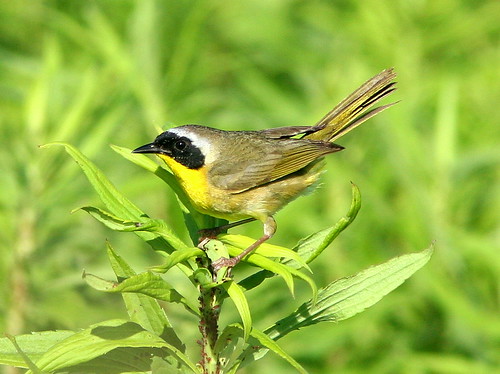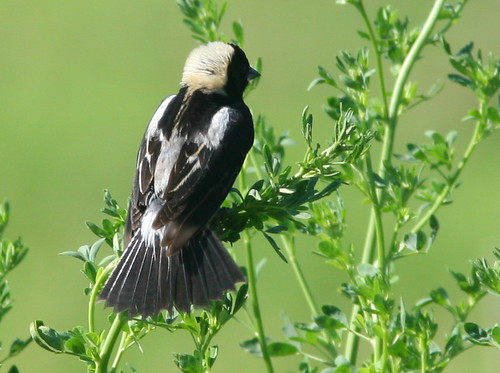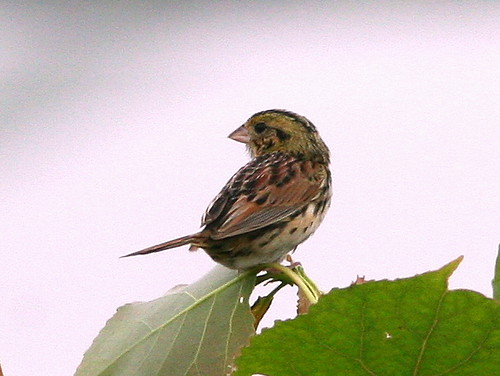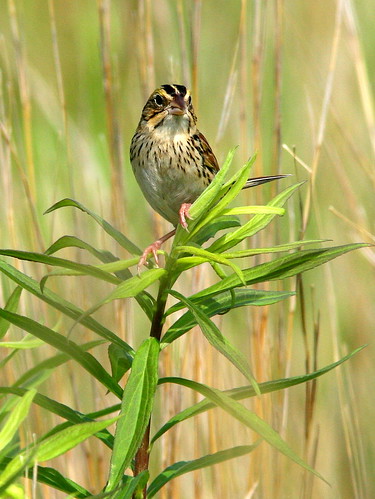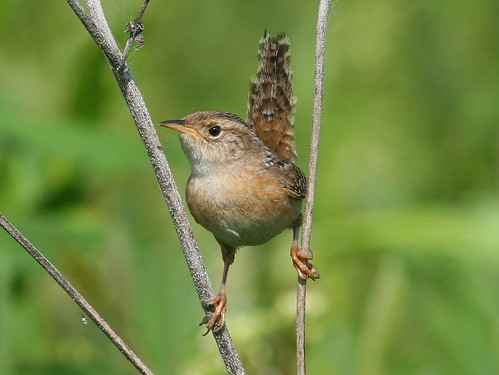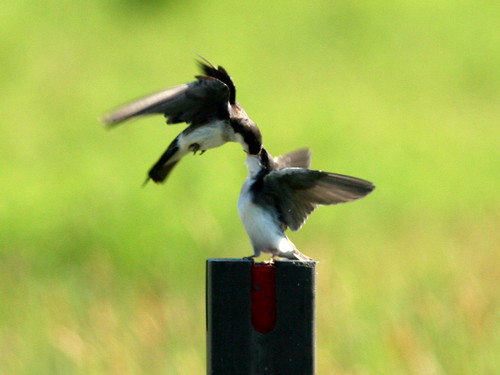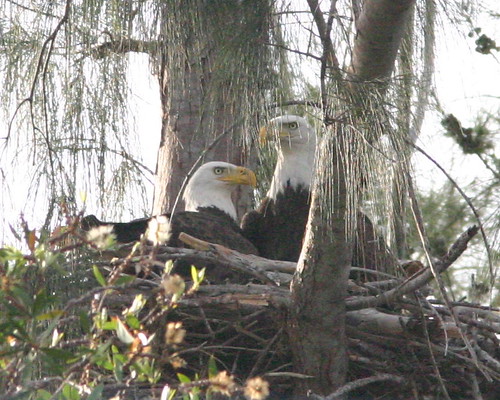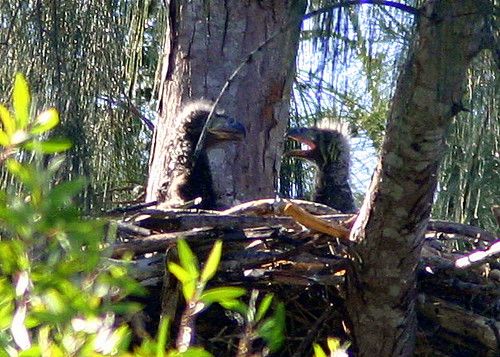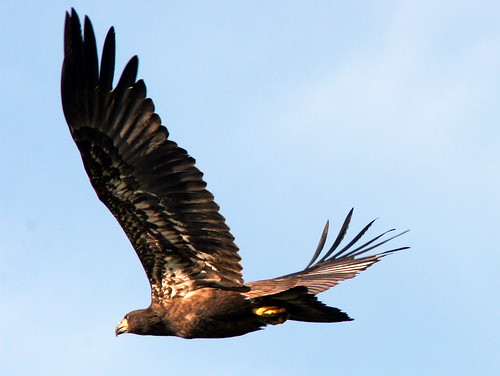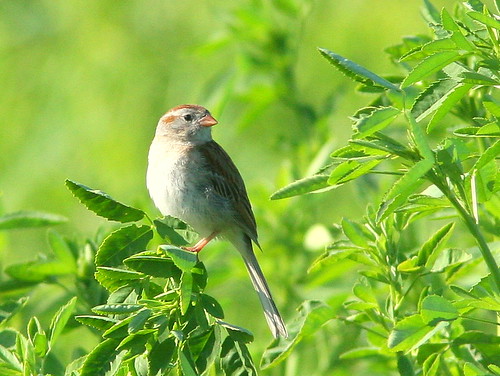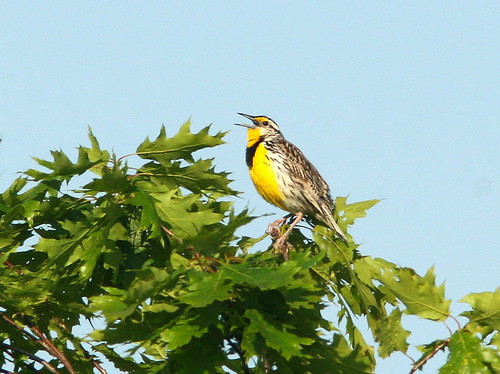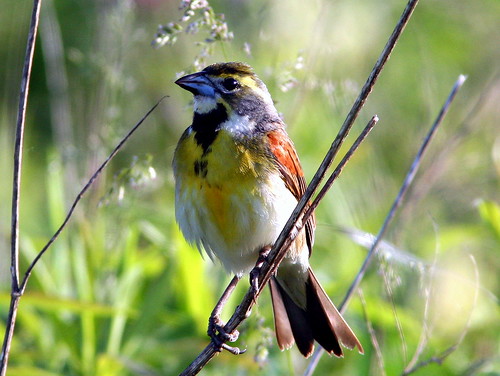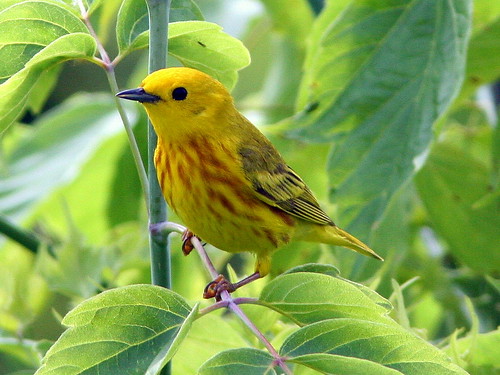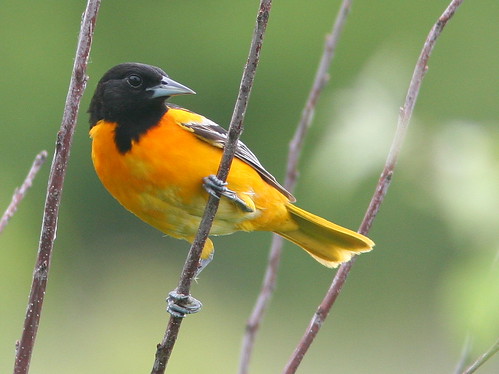(Click on images for larger views. View a slide show of Nelson Lake morning walks at end of this post)
After a hot spell, the Illinois mornings have turned cool, and yesterday morning’s walk in nearby Nelson Lake Forest Preserve was sunny, breezy and a chilly 65 degrees. The wind rustled the prairie grasses and attenuated the sounds of the birds. The voices of many Red-winged Blackbirds, meadowlarks, Dicksissels, yellowthroats and Song Sparrows rose above the wind.
Dicksissel singing:
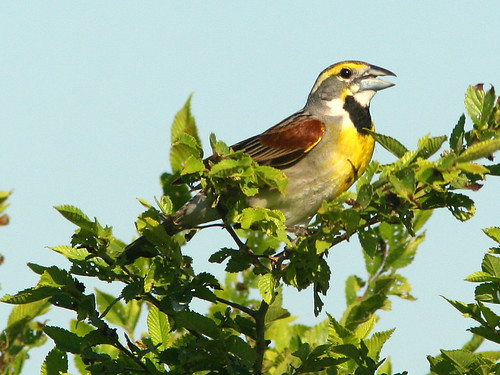
Common Yellowthroat:
Eastern Meadowlark:
Savannah and Grasshopper Sparrows were strangely silent, as they foraged along the path. The warm morning light enhanced the yellow on this Savannah Sparrow’s brow:
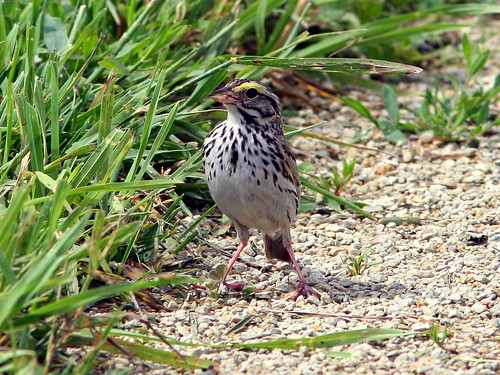
The bright highlights in this Grasshopper Sparrow’s plumage surprised me:
The rollicking song of a single Bobolink caught my attention as he flew overhead. I had hoped to get some better photos of Bobolinks, but there were none in the area where we suspected they were nesting only a couple of days before.
I photographed this Bobolink on our previous Nelson Lake walk, on June 22. Its hindcrown appeared much more yellow in life:
We listened for the elusive Henslow’s Sparrows, but if any were singing, they could not be heard above the whistling wind. To human ears, the “song” of a Henslow’s hardly deserves to be called that, as it consists only of a single “chir-lip,” delivered monotonously at intervals of about 10 seconds. The bird seems to put its whole heart and soul into each brief rendition, thrusting up its bill and often closing its eyes as if enjoying the sound of its own voice. The song resembles the call of a House Sparrow, somewhat shortened, rather loud but often muffled by the tall grasses swaying in the breezes. It has a ventroliqual quality, seeming to come from very nearby, but getting ever louder as one approaches the vicinity of the songster. At one point it was so hard to localize that it sounded as if the bird were sitting right on top of my hat!
Only a few days ago, two territorial Henslow’s Sparrows serenaded us from low perches close to the path: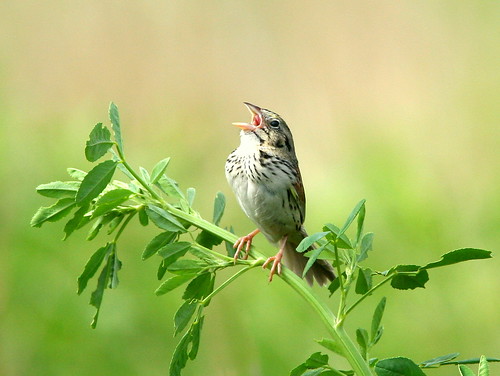
Note the rusty wings and distinctive olive-greenish cast to the head of the Henslow’s Sparrow:
This is our second summer in Illinois, and last year we were delighted to find several singing Henslow’s Sparrows. This year there were none in their old haunts, probably for a good reason. A controlled burn had altered their habitat. The fire had cleansed the prairie of woody plants that can quickly change it into a savannah and then a woodland. It also returned valuable nutrients into the soil. As a result, the grasses had sprung up fresh and green, and wildflowers bloomed profusely. Why were there no Henslow’s Sparrows?
These tiny birds, only 4 1/2 inches long and weighing less than a half an ounce, once were very numerous on the central plains. As has been the case with other grassland birds, the population of Henslow’s Sparrows declined sharply around the middle of the 20th Century. In Illinois, studies suggest that the population of Henslow’s Sparrows declined as much as 94% between 1957 and 1979. Partners In Flight designated this species as its highest priority among all grassland birds for conservation in the midwestern United States. The greatest decreases in songbirds have occurred among grassland species, and the Henslow’s Sparrow has been the hardest hit of all.
Large open expanses of tall grass prairie are essential for the breeding success of Henslow’s Sparrows. They will not nest in smaller patches of otherwise suitable habitat. Most important in the decline of these birds was the conversion of the prairies into cropland. In the midwest, over 99% of the original grasslands have disappeared. Disruption of the natural cycle of prairie fire has also been detrimental. These sparrows will not nest in an area that has been burned over in the previous year, as they require an accumulation of dead grass left over from at least one winter. The second through the fourth year after a burn seem to supply just the right amount of ground litter. In subsequent years, as woody plants and taller forbs thrust up above the chest-high grasses, the birds fail to return to the same place to nest. Since they are loosely colonial, they may all disappear at once, only to show up somewhere else, where the succession from fire to lush grassland is at just the right stage. That probably explains why I no longer found them nesting in last year’s haunts.
Coneflowers bloomed on the prairie:
A Sedge Wren popped up unexpectedly, quite a distance from the wetland:
In a small tree near the north entrance to the prairie, a family of Tree Swallow chicks waited to be fed:
An adult hovers while feeding its fledgling:
Nelson Lake Slide Show. Click lower right corner of image for full-screen view:
Pair of Bald Eagles at nest on December 11, 2008, two days before the first egg was laid:
Our eldest daughter just paid me a compliment that I almost let go unnoticed. We parents want so much to provide good example and instill values and lofty aspirations in our children. So often, we fall short. We learn from our mistakes, and hope that our kids do likewise. We do a lot of preaching and coaching, but maybe the most important signals we send are much more subtle.
At the end of the school year, Karen and her husband embarked on an extended camping trip from Arizona through the heart of our nation, visiting our son Ken’s family in the Texas Panhandle, and then hopping from one campground to another to Wyoming, Yellowstone National Park, Montana, and the Dakotas. On their way back, in Utah, they parked the camper in a particularly isolated and scenic location. Deprived of a WiFi hotspot and unable to pick up a TV signal, her husband was a bit disappointed at being out of touch with the world. In the morning, Karen looked out the window and saw a deer browsing only a few feet away. She called Randy, “Look, a Mulie!”
Both of them immediately forgot about the lack of electronic entertainment and lavished the views provided through the courtesy of Mother Nature. First, Randy wanted to confirm Karen’s impression as to the species of deer, saying to look at its hindquarters for markings that separate white-tails from Mule Deer. Karen said, no, “Look at it ears– just like a mule! My Dad taught me that a long time ago”
After calling me to relate this little anecdote, Karen said, rather solemnly, “You know, Dad, one of the best things you ever did for me was to give me an appreciation of nature.” Our conversation then moved into a discussion of some of the great natural places we visited when we used to pack the kids into a station wagon and just go.
At 22 days of age, Hope, the eldest of the two chicks, peers over the rim of the nest:
On February 15, the 4 week old chicks delight the nest observers:
What opens one’s eyes to the wonders of nature? The great birder and author Roger Tory Peterson described his “epiphany,” when, as a child, he picked up an apparently dead flicker and it sprung to life in his hands and flew off. There was something about seeing the beauty of the bird’s intricate and colorful plumage so close at hand that ignited a passion that was to change the world, not only for Roger, but for so many who found, in his field guides, a portal that, once opened, would never close (Readers might be interested in how a similar thing happened to my wife, Mary Lou, upon first sighting an Elegant Trogon).
We have seen such a transformation occur among many of the people who visited our neighborhood Bald Eagle nest in Pembroke Pines, Florida. With a little help from the volunteer nest-watchers, “lookers” often turned into “observers” right before our eyes. As observers, they instantly developed an insatiable thirst for knowledge and understanding, that may lead to greater appreciation and concern, and spill over into a new ethic of conservation.
Hope flies freely on May 21, 2009:
In my Review and reflections on Liz Rosenthal’s biography of Roger Tory Peterson, I wrote:
…It was my mother who introduced me to Roger, unwittingly fanning a spark that was to grow into a flame. Only today, facing the irony of a recession and the specter of another Depression, do I realize what a sacrifice it was for my mother to spend $2.75 for the 1939 revision of the first edition of Peterson’s A Field Guide to the Birds. In today’s economy, that comes to $34.37, plus tax. The book supercharged my interest in birding and opened the door to a lifelong hobby– it might be called an obsession…
Father Tom Pincelli, the Brownsville priest-birder who serves on the board of the National Audubon Society, said it so well: “Openness to the natural world and our response to it lie at the core of what we do and why we do it.”
Related Blog entries on this subject:
“Discovering Birds” (how I evolved into a bird watcher)
How Mary Lou Became a Birder
“Birding is a fascinating, exciting, challenging game. It requires and encourages ever-growing skill. It may involve us in great adventures and wide travel, sometimes in difficult terrain. Seeking new birds to check off on our life lists may draw us further into the lives of these birds, challenging us to learn more about their life cycles, their behaviors, and ecology; and as our ecological perspectives expand, we may be stimulated to become more involved in conservation work, to protect the habitats of the many species we enjoy.” (Burton S. Guttman, Birding, February 2004)
Click on arrow, then on the little box in the lower right corner for a full-screen slide show of my photos taken at Nelson Lake:
I do miss visiting the local Bald Eagle nest in Pembroke Pines, Florida. Those frequent short trips to the eagles’ territory usually yielded great views of the majestic raptors. Their first chick fledged 66 days ago, on May 4, and the second left the nest two days later. Although they soon flew freely and effortlessly and by now have surely developed their hunting instincts, they continued to return to the nest for occasional feedings from the parents– that is, until May 22, after which Hope, the older eaglet, suddenly disappeared. At about the same time, the adult female disappeared, leading us to speculate that they may have migrated together. As of this writing, it appears that Justice, who was last observed being fed at the nest on May 30, was last seen on June 4, along with one remaining adult. For the latest information on the eagle nest, tune into the eagle-watchers’ observations and photos in this FORUM.
Unlike songbirds that fly south in winter, the timing and direction of migration of Bald Eagles varies quite a bit. Those from Canada and the northern tier of the United States tend to winter to the south, but only as far as necessary for them to find open water for fishing. Southern eagles, which lay their eggs in the dead of winter and fledge before the beginning of summer, usually move to the north during the hot summer. We can only speculate as to where the locals birds are wandering. Eagles from more southerly nests at the tip of the Florida peninsula tend not to fly great distances on migration, staying generally south of Lake Okeechobee. More northerly eagles move up the Atlantic coast, often to Maryland and Virginia, where they have been known to congregate on Chesapeake Bay. The Pembroke Pines birds are actually in between these two geographic distributions. Without radio tracking and/or colored bands, there is no way of knowing where they are.
We just hope that the adults continue the usual pattern of returning to their territory around October or November to refurbish their nest and prepare for egg-laying in mid-December. By then, we hope that the official designation of their territory as a City of Pembroke Pines Bald Eagle Sanctuary will have been accomplished.
Here in Ilinois, we see many birds that are transitory or scarce in Florida. Just after dawn on June 5, we hurried to Nelson Lake Marsh/Dick Young Forest Preserve in Batavia, Illinois, about 2 miles from our home. We entered by way of the newer north entrance, from which a paved path leads past a wetland area into extensive tall grasslands, hoping to see some species that favor such open spaces. We were not disappointed.
The Field Sparrow is usually shy and retiring, but this one posed nicely along the path:
An Eastern Meadowlark sang carols from the top of a small oak tree:
As we watched a tiny Grasshopper Sparrow in a small bush, it surprised us by flying towards us and landing on a gravel path:
Before it took off, the sparrow stretched up, casting an over-sized early morning shadow: 
Dicksissels were abundant, and this one looked especially colorful in the harsh morning light:
Numerous Song Sparrows sang from the tops of shrubs killed by controlled burns that rejuvenated the grasslands:

I could not resist taking a photo of a goldfinch hiding among the goldenrods:
The cool end of the color spectrum was represented by this Indigo Bunting: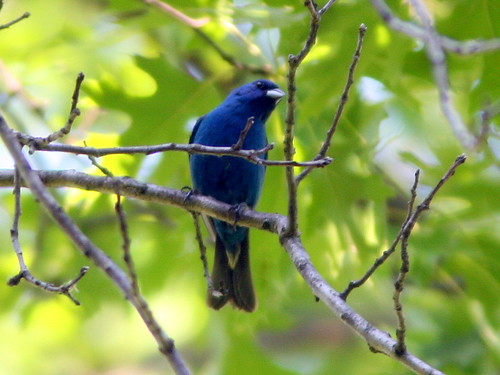
This morning, Mary Lou and I returned to Nelson Lake for a pleasant two-hour walk. This time we came in the east gate, where the habitats varied from open grassland to second growth hardwood woodlands. The skies were overcast, and it was cool (by Florida standards) 61 degrees with little wind. We walked leisurely along the southern perimeter of the lake, taking in the songs of local resident birds: scores of Common Yellowthroats, robins, catbirds and goldfinches, and at least a dozen Swamp Sparrows. The latter stayed out of sight as their loud trills filled the air. Also invisible were a Marsh Wren and several Sedge Wrens. Several Turkey Vultures tilted above. A Brown Thrasher sang vigorously. At first I thought I was hearing a mockingbird, as this thrasher violated the norm by often repeating the same melodic phrases more than twice, even launching into a stanza of variations on a single series of tones, repeating it even five or six times.
A Yellow Warbler with particularly bright plumage greeted us this morning:
This Baltimore Oriole competed for the distinction of being the bird with the most brilliant coat:
As we were walking back to the parking lot, a large dark bird rose up from near the edge of the lake. At first we almost dismissed it as another vulture, but many hours of eagle-watching back home paid off, as we both recognized the familiar shape of a Bald Eagle: long narrow wings held out flat, elongated head and neck, and substantial fanned tail. The lighting conditions were so poor that we were uncertain as to whether it had the all-white head and tail of an adult. Seeing the eagle made us suddenly feel closer to our eagle-watching friends in Florida.
Back home, my photos (with apologies for their poor quality) confirmed that the eagle was at least four or five years old, as its head and tail were pure white:














